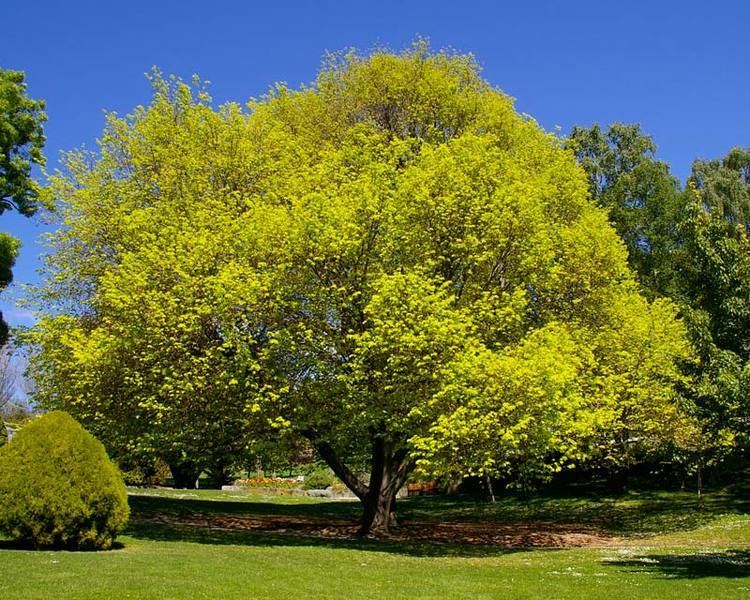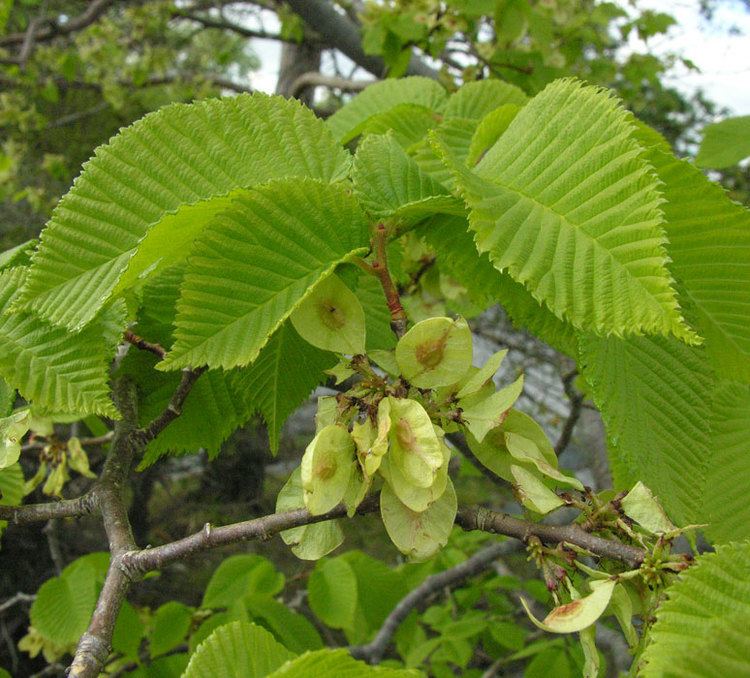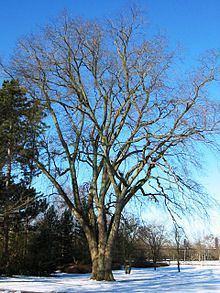Scientific name Ulmus glabra Rank Species | Genus Ulmus Higher classification Elm | |
Similar Elm, Ulmus minor, Ulmus laevis, Tilia cordata, Fraxinus excelsior | ||
Ulmus glabra
Ulmus glabra, the wych elm or Scots elm, has the widest range of the European elm species, from Ireland eastwards to the Urals, and from the Arctic Circle south to the mountains of the Peloponnese in Greece; it is also found in Iran. A large, deciduous tree, it is essentially a montane species, growing at elevations of up to 1500 m, preferring sites with moist soils and high humidity. The tree can form pure forests in Scandinavia and occurs as far north as latitude 67°N at Beiarn in Norway. Wych elm has also been successfully introduced to Narsarsuaq, near the southern tip of Greenland (61°N).
Contents
- Ulmus glabra
- Etymology
- Subspecies
- Description
- Pests and diseases
- Cultivation
- Wood
- Notable trees
- Cultivars
- Hybrids and hybrid cultivars
- Accessions
- References
The tree was by far the most common elm in the north and west of the British Isles and is now acknowledged as the only indisputably British native elm species. Owing to its former abundance in Scotland, the tree is occasionally known as the Scotch or Scots elm; Loch Lomond said to be a corruption of the Gaelic Lac Leaman interpreted by some as 'Lake of the Elms', 'leaman' being the plural form of leam or lem, 'elm'. However, this is contested, the correct Gaelic name considered Loch Laomainn, its origin obscure.

Closely related species, such as Bergmann's elm U. bergmanniana and Manchurian elm U. laciniata, native to northeast Asia, were once sometimes included in Ulmus glabra; another close relative is the Himalayan or Kashmir elm U. wallichiana.

Etymology

The word wych (also spelled witch) comes from the Old English wice, meaning pliant or supple, which also gives us wicker and weak. An older name for the tree was "wych hazel", perhaps based on the similar appearance of hazel and wych elm shoots.
Subspecies
Some botanists, notably Lindquist (1931) have proposed dividing the species into two subspecies:

However, there is much overlap between populations with these characters, and the distinction may be owing to environmental influence, rather than genetic variation; the subspecies are not accepted by Flora Europaea.
Description
The wych elm sometimes reaches heights of 40 m, typically with a broad crown where open-grown, supported by a short bole < 2 m. d.b.h. There are not normally root suckers; natural reproduction is by seed alone. The tree is notable for its very tough, supple young shoots, which are always without the corky ridges or 'wings' characteristic of many elms. The alternate leaves are deciduous, 6–17 cm long by 3–12 cm broad, usually obovate with an asymmetric base, the lobe often completely covering the short (<5 mm) petiole; the upper surface is rough. Leaves on juvenile or shade-grown shoots sometimes have three or more lobes near the apex. The perfect hermaphrodite flowers appear before the leaves in early spring, produced in clusters of 10–20; they are 4 mm across on 10 mm long stems and, being wind-pollinated, are apetalous. The fruit is a winged samara 20 mm long and 15 mm broad, with a single, round, 6 mm seed in the centre, maturing in late spring.
U. glabra subsp. montana
Pests and diseases
While the species is highly susceptible to Dutch elm disease, it is less favoured as a host by the elm bark beetles which act as vectors. Research in Spain has indicated the presence of a triterpene, alnulin, renders the tree bark less attractive to the beetle than the Field elm. Moreover, once the tree is dying, its bark is quickly colonized by the fungus Phoma, which radically reduces the amount of bark available for the beetle to breed on. In European trials, clones of apparently resistant trees were inoculated with the pathogen, causing 85 – 100% wilting, resulting in 68% mortality by the following year. DNA analysis by Cemagref (now Irstea) in France has determined the genetic diversity within the species is very limited, making the chances of a resistant tree evolving rather remote.
The Swedish Forest Tree Breeding Association at Källstorp produced triploid and tetraploid forms of the tree, but these proved no more resistant to Dutch elm disease than the normal diploid form.
In trials conducted in Italy, the tree was found to have a slight to moderate susceptibility to elm yellows, and a high susceptibility to the elm leaf beetle Xanthogaleruca luteola [5].
Cultivation
The wych elm is moderately shade-tolerant, but requires deep, rich soils as typically found along river valleys. However, the species is intolerant of flooding, as it is of prolonged drought. Although rarely used as a street tree owing to its shape, it can be surprisingly tolerant of urban air pollution, constricted growing conditions and severe pollarding.
As wych elm does not sucker from the roots, and any seedlings are often consumed by uncontrolled deer populations, regeneration is very restricted, limited to sprouts from the stumps of young trees. The resultant decline has been extreme, and the wych elm is now uncommon over much of its former range. It is best propagated from seed or by layering stooled stock plants, although softwood cuttings taken in early June will root fairly reliably under mist.
Wood
Wych elm wood is prized by craftsmen for its colouring, its crazy grain, its 'partridge-breast' or 'catspaw' markings, and, when worked, its occasional iridescent greenish sheen or 'bloom'. The bosses on old trees produce the characteristic fissures and markings of 'burr elm' wood. Bosses fringed with shoots are burrs, whereas unfringed bosses are burls.
Notable trees
Perhaps the most famous wych elm avenue was The Long Walk, Windsor Great Park, planted in the 1670s on the instruction of John Evelyn and described by Elwes as "one of the finest and most imposing avenues in the world". The wych elms were felled in 1943.
E. M. Forster cites a particular wych elm, one that grew at Rooks Nest, Stevenage, Hertfordshire, sixteen times in his novel Howards End. This tree overhangs the house of the title and is said to have a "....girth that a dozen men could not have spanned.." Forster describes the tree as "...a comrade, bending over the house, strength and adventure in its roots." The wych elm of the novel had pigs' teeth embedded in the trunk by country people long ago and it was said that chewing some of the bark could cure toothache. In keeping with the novel's epigraph, "Only connect...", the wych elm may be seen by some as a symbol of the connection of humans to the earth. Margaret, the novel's protagonist, fears that any "....westerly gale might blow the wych elm down and bring the end of all things..." The tree is changed to a chestnut in the 1991 film adaptation of Howards End.
The UK Champion listed in The Tree Register of the British Isles (TROBI) is at Brahan in the Scottish Highlands; it has a girth of 703 cm (2.23 m d.b.h.) and a height of 24 m [6]. The oldest specimen in Edinburgh (2016) is believed to be the tree (girth 5.2 m) in the former grounds of Duddingston House, now Duddingston Golf Course. Other notable specimens in Edinburgh are to be found in Learmonth Gardens and The Meadows.
In 1998, over 700 healthy, mature trees were discovered on the upper slopes of Mount Šimonka in Slovakia, but it is now believed they had survived courtesy of their isolation from disease-carrying beetles rather than any innate resistance; 50 clones of these trees were presented to HRH The Prince of Wales for planting at his Highgrove Estate, and at Clapham, Yorkshire [7].
Cultivars
About 40 cultivars have been raised, although at least 30 are now probably lost to cultivation as a consequence of Dutch elm disease and/or other factors:
Some elm cultivars of unconfirmed derivation, such as the Exeter Elm and the dwarf elm 'Nana', were classified until recently as forms of U. glabra. Camperdown Elm is usually classified as an U. glabra sport.
Hybrids and hybrid cultivars
U. glabra hybridises naturally with U. minor, producing elms of the Ulmus × hollandica group, from which there have arisen a number of cultivars:
A crossing in Russia of U. glabra and U. pumila, the Siberian Elm, produced the hybrid Ulmus × arbuscula.
Hybrids with U. glabra in their ancestry have featured strongly in recent artificial hybridization experiments in Europe, notably at Wageningen in the Netherlands, and a number of hybrid cultivars have been commercially released since 1960. The earlier trees were raised in response to the initial Dutch elm disease pandemic that afflicted Europe after the First World War, and were to prove vulnerable to the much more virulent strain of the disease that arrived in the late 1960s. However, further research eventually produced several trees effectively immune to disease, which were released after 1989.
